

Lecture Capture Policies: A Survey of British Universities Yasmin Ibrahim, Anita Howarth & Ian Stone Postdigital Science and Education volume 3, pages144–161(2021) We found a marked increase in the number of HEIs using some form of LC signalling the coming of age of this technology from the periphery to the mainstream.
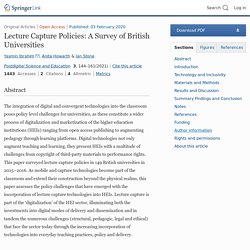
The main justifications given for increased appropriation included student demand, pedagogic benefits of a revise-and-review tool and the obligation to meet the needs of those with learning or language difficulties. Even though government (i.e. Department for Business Innovation and Skills 2015) has avoided prescribing the use of technology to cover the funding gap in disability support, HEIs have nevertheless identified LC as an obvious ‘solution’ to the shortfall and an important mechanism in meeting their statutory obligations to make reasonable adjustments for disabilities (JISC 2016). Content Analysis Findings: A Quantitative Overview of the Sector Expansion of Lecture Capture across the Sector In the 2011/2012 study, 31% (34 out of a sample of 108 in 2011/2012) had some form of provision, policy or plan to develop LC.
SAGE Journals: Your gateway to world-class journal research. In early 2020, most universities around the world scrambled to move all their classes online in response to the COVID-19 pandemic (Lee, 2020).
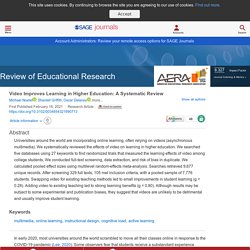
Some observers fear that students receive a substandard experience online and that universities should transition back to in-person teaching as soon as possible (Deming, 2020). Others suggest that many students lack both social and technical support that are needed to access online learning (Warschauer & Matuchniak, 2010). This problem is exacerbated in less affluent countries (Valenzuela-Levi, 2020) and may create a harmful feedback loop where differential access may increase gaps in achievement (Johnson & Mejia, 2014). Although many such concerns may be valid, meta-analyses suggest that online and distance learning can be viable replacements for face-to-face teaching (Means et al., 2009, 2010; Means et al., 2013). By being asynchronous, videos allow the teacher to have more control over the presentation via editing. Method Eligibility Criteria.
Lectures on the way out in Australia and New Zealand, says survey. 2020-2021 Spring - PSY 1: Introduction to Psychological Science : Panopto. Videos you create and videos shared with you will appear here.
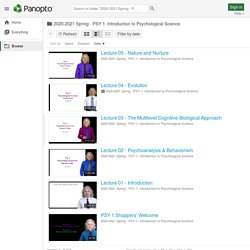
Record your first video by clicking "Create" at the top of the page. Learn More Videos created by you and others in your organization will appear here. You can create videos by clicking "Create" at the top of the page. Learn More This list contains no videos. This folder contains no videos. It’s not production quality that counts in educational videos – here's what students value most. The use of educational videos in schools and universities was on the rise before COVID-19.
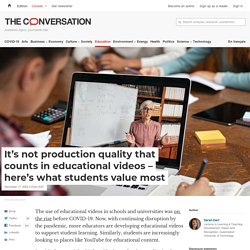
Now, with continuing disruption by the pandemic, more educators are developing educational videos to support student learning. Similarly, students are increasingly looking to places like YouTube for educational content. Intuitively, we might think a video’s production quality is what matters – fancy recording equipment, a professional studio environment and flawless editing. While these “bells and whistles” can be attractive, some of the most successful educational YouTube channels actually use very simple production styles.
Tandfonline. OU tutorial recording policy. A socially progressive case for lecture capture. Hashtag #CIEVideoLearn20 sur Twitter. Lecture capture – don’t fight it, feel it. Lecture capture would be a strange choice of hill for me to die on since I work at a university that doesn’t do lectures, and have no experience of it.
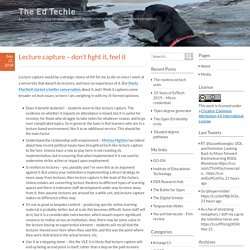
But Sheila MacNeill started a twitter conversation about it, and I think it captures some broader ed tech issues, so here I am, weighing in with my ill-formed opinions. Does it benefit students? – students seem to like lecture capture. The evidence on whether it impacts on attendance is mixed, but it is useful for revision, for those who struggle to take notes for whatever reason, and to go over complicated topics. Lecture-free universities are the future – and they will transform the way we learn forever. Study: Lecture capture reduces attendance, but students value it. One of the biggest studies of its kind to date has concluded that although the introduction of lecture capture does lead to reduced class attendance, academics must accept that students see it as a valuable part of the learning experience.
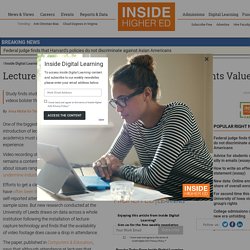
Video recording of teaching is now common on most Western campuses, but it remains a contentious issue for some academics, who have raised concerns about issues ranging from intellectual property rights to the use of footage to undermine industrial action, as well as the impact on students’ attendance. Story continued below… Enjoying this article from Inside Digital Learning? Sign up for the free weekly newsletter. Time for university educators to embrace student videography. The authors provide an interdisciplinary investigation of student videography for assessment in higher education.
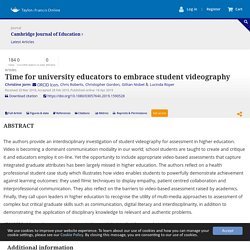
Video is becoming a dominant communication modality in our world; school students are taught to create and critique it and educators employ it on-line. Yet the opportunity to include appropriate video-based assessments that capture integrated graduate attributes has been largely missed in higher education. The authors reflect on a health professional student case study which illustrates how video enables students to powerfully demonstrate achievement against learning outcomes: they used filmic techniques to display empathy, patient centred collaboration and interprofessional communication.
Johns Hopkins University Press Books. The Myth of Passive Learning. Every once in a while it happens…it’s called insight in my psychology class; that ah-ha moment when the light bulb switches on in your head.
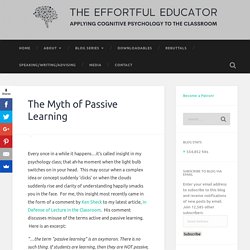
This may occur when a complex idea or concept suddenly ‘clicks’ or when the clouds suddenly rise and clarity of understanding happily smacks you in the face. For me, this insight most recently came in the form of a comment by Ken Sheck to my latest article, In Defense of Lecture in the Classroom. His comment discusses misuse of the terms active and passive learning. Here is an excerpt: “…the term “passive learning” is an oxymoron. Yes. So, back to Mr. Eureka…so simple…so poignant. University of Edinburgh Lecture Recording Team - #LTA6. To provide or not to provide course PowerPoint slides? The impact of instructor-provided slides upon student attendance and performance.
Theunionmmu Lecture Capture Report. Accept lecture capture despite attendance drop, says dean. Donald Clark Plan B. I first saw Roger Schank talk in Denver, Colorado, over 25 years ago and have barely disagreed with a word he’s said since.
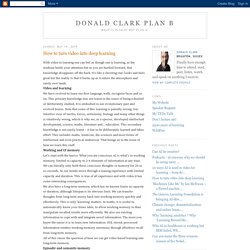
Schank is a critic of the current educational system, pointing to 19th century curriculum, teaching by telling, lectures, memorisation and standardised tests, as structures and techniques that distort learning. I’ve seen him ask audiences of academics to tell him the quadratic equation, taught to most children – they can’t. I’ve seen him ask audiences about the safety briefing on a 737, something they’ve seen dozens of times – they can’t. Emily Nordmann sur Twitter : "A systematic review this is not, it's for a slide for a talk but when I say that overall the evidence doesn't support that recording lectures negatively impacts attendance this is what I mean. Yes, some studies do find it, bu. 10 Video Trends That Can Enhance The Student Learning Experience. Video has quickly become a dominant learning and communications medium in higher education.

Panopto recently commissioned new research in partnership with youth trend experts Voxburner to find out what students really think about video learning technologies. More than 500 university students from 135 different UK higher education institutions from across the higher education sector took part. International Journal of Educational Technology in Higher Education. Conventional teaching and learning method is no longer appropriate for the learner’s current association with the technology. Therefore technology-enabled learning (TEL) plays a vital role in contemporary education structures.
The literature further says that the basic and fundamental problem of the traditional teaching process is that the faculty members often equate their learning process to their students’ (Liyoshi & Vijay-Kumar, 2008). As mentioned in the introduction, OER is teaching and learning materials that are freely available online for everyone to use. Larsen and Vincent-Lancrin (2005) OER has further defined that, “The open sharing of one’s educational resources implies that knowledge is made freely available on non-commercial terms,”. The OER-based online learning is the latest method of learning since the learners and the teachers get the freedom of using the copyright free materials for the academic work (Karunanayaka et al., 2016).
Timeshighereducation. Changing the conversation around video – Neil Mosley. And so the lecture capture debate keeps raging on in UK higher education fuelling a culture of distrust in universities that seems to have set in. Of course there are other factors that have caused this like the pension dispute, but increasingly there’s a growing divide between “us” and “the university”. Eighty-six per cent of higher education institutions now have lecture capture technology on site. Medical students are skipping class, making lectures increasingly obsolete. The future doctors of America cut class. Not to gossip in the bathroom or flirt behind the bleachers. They skip to learn — at twice the speed. Lecture capture – don’t fight it, feel it. Lecture Highlights: repurposing of lecture capture to focus on essential concepts. Daniela Plana, Teaching Fellow in Chemistry, Keele University The term “lecture capture technology” has been used in the literature to encompass a range of different technologies, ranging from pre-recording lectures in a separate environment to the recording of live lectures and their later distribution to students.[1-4] At Keele Playback is currently used, which allows for the audio (mainly the lecturer) and the screen to be recorded (both through projection from a computer or using a visualiser).
Videos triangle. Lecture Attendance, Lecture Recordings, and Student Performance: A Complex, but Noteworthy Relationship. Oh, if only there was a study that looked into the relationship between lecture attendance and recordings...You might have guessed it: There is such a study. Centre for Excellence in Learning and Teaching. Insights from literature on lecture capture. Peter McKenna from the faculty of Science and Engineering at Manchester takes a look at the literature… While students feel that recordings enhance their learning and don’t impact on their attendance, most studies report that there is no significant impact on grades (Kushnir et al. 2011; Leadbeater et al. 2013) and that attendance drops (Traphagen et al, 2009; Marchand et al, 2014; Bos et al, 2015).
Video Learning Analytics. UCL’s new Lecturecast system is live. By Janice K M Kiugu, on 28 September 2017 This summer the Lecturecast service received a significant upgrade when we moved from our previous lecture capture solution to the latest offering from our supplier Echo360. HeLFLectureCapture2017.